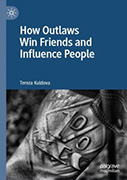How Outlaws Win Friends And Influence People

Author: Tereza Kuldova
Publisher: Cham, SWIT: Palgrave Macmillan, 2019. 214p.
Reviewer: Kevin Cassidy | September 2019
Tereza Kuldova examines the inner workings of ‘outlaw bikers’ and provides insight into the stereotypical ideology that society has regarding biker gangs and what they represent. She writes “[t]he popularity of outlaw motorcycle clubs is most pronounced among those who are disillusioned, hopeless, and frustrated by the harmful effects of neoliberal capitalism, and those who feel abandoned by the state, which they view as, if anything, increasingly curbing their freedoms as opposed to protecting their real interests.” This might be said of society in general, and not just be the ideology of outlaw bikers.
In the prologue she writes “[t]oday, outlaw motorcycle clubs are no longer deviants, even if they operate at what the bourgeois would deem the ‘margins,’ where the legal and the illegal are ultimately bound together.” However, according to Europol “[w]hile most members of motorcycle clubs around the world are law abiding, a small percentage are not. Styling themselves `outlaws’ or `one-percenters,’’ they wear a patch on their jackets showing a 1 % sign inside a diamond shape. This means that they belong to an outlaw motorcycle gang, such as the Hells Angels, Bandidos or Outlaws.” Although there seem to be contradicting views regarding outlaw bikers, Kuldova quotes Hegel’s maxim, “the familiar is not necessarily the known.” Meaning, despite what books, movies and what law enforcement agencies may say about them, some members of society are intrigued by bikers and agree with the biker’s lifestyle and philosophy.
According to the FBI’s 2013 National Gang Report, outlaw motorcycle gangs represent a small minority of gang activity in the United States. The FBI estimates that 88 percent of gang members are in street gangs, 9.5 percent are in prison gangs, and the remaining 2.5 percent are in motorcycle gangs. Placing statistical data to the side, the book delves into the various reasonings and motivations as to why some members of society support, admire and affiliate themselves with outlaw bikers. You may agree or disagree with some of Kuldova’s reasons behind her opinions, but her writing provides insight into why some members of society admire outlaw bikers, and how these bikers can impact or influence society as well. Her research covered bikers in the United States, Austria, Germany, Slovakia and the Czech Republic. She also provides information on the history of the Hells Angels, the Black & White Crew and how the outlaw bike culture was born at the end of the Second World War.
The book discusses both society’s views and the bikers’ views on why bikers are perceived as an overall threat to mainstream society. The main threat to public safety from outlaw motorcycle gangs seemingly stems from their propensity for extreme forms of violence. The use of intimidation and violence is intrinsic to the subculture of outlaw motorcycle gangs, and serves to exert control over group members, rival gangs and others, such as the victims of extortion.
The book’s chapters are well written and organized. The prologue and epilogue contribute to the five chapters and provide background information to support the author’s ideas and reasoning. She makes valid arguments as to why there is a fascination with outlaw bikers and why they have been labeled as being dangerous by others. An underlying tone of the book is the idea that the rapid disintegration of social bonds in the context of a neoliberalism ideology has greatly affected society, and helps explain why there has been a rise in motorcycle clubs and other similar organizations globally.
Kevin Cassidy-Professor in the Security, Fire & Emergency Management Department at John Jay College. He is also a member of ASIS.


